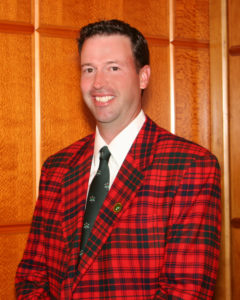 Ty Butler is currently the vice president and senior project architect of the Robert Trent Jones Jr design company, based in Charlotte, North Carolina. He worked on the Kaluhyat Course at Turning Stone Casino Resort, in Verona, New York; Rock Barn Golf and Spa in Conover, North Carolina; and Charter Oak Country Club in Hudson, Massachusetts. Butler also designed the Reef Course at Our Lucaya Resort in Freeport, Grand Bahama Island, and Margarita Golf Club in Margarita Island, Venezuela.
Ty Butler is currently the vice president and senior project architect of the Robert Trent Jones Jr design company, based in Charlotte, North Carolina. He worked on the Kaluhyat Course at Turning Stone Casino Resort, in Verona, New York; Rock Barn Golf and Spa in Conover, North Carolina; and Charter Oak Country Club in Hudson, Massachusetts. Butler also designed the Reef Course at Our Lucaya Resort in Freeport, Grand Bahama Island, and Margarita Golf Club in Margarita Island, Venezuela.
I began playing golf when I was eight years-old, and to be honest, I absolutely hated the game. However, my mother insisted that I join the junior golf program at my parents’ club in Arkansas City, Kansas. I was part of the “three holers” group that first summer, and I beat it around in the blazing heat with the rest of the kids. I averaged a respectable ten to twelve strokes per hole – not bad for a “three holer.” By the second summer, I was hooked on the game for good.
I remember sitting around the house during all those frozen Kansas winters, while the courses were covered by a blanket of snow, drawing imaginary golf courses. To me, it was a lot like putting a puzzle together: fitting in all the pieces until it was perfect, based only on my limited knowledge of what a golf course looked like from my then short golfing career. I remember thinking it would be great if this actually existed as a job and I could do it when I grew up.
A short time later my mother encouraged me again by giving me a a copy of Golf’s Magnificent Challenge, by the renowned golf course architect Robert Trent Jones Sr. It was the most interesting book I had ever read, because it was about the very profession that I thought only existed in my imagination. The stories about Jones’s life as a golf course architect and the various projects he had designed around the world convinced me, at the age of twelve, that I wanted to spend my life creating golf courses. But I had no idea how to go about reaching my newfound goal.
I met Dick Metz when I was fifteen years old, working my summer job on the grounds crew at Arkansas City Country Club. Dick had been a professional golfer in the 1920s and played in the inaugural Masters Tournament in 1934. I was riding on a tractor, pulling a seven gang reel mower down the thireenth fairway. Metz played the course every morning. This particular morning he came strolling down the fairway I happened to be mowing, so I paused to let him play on. As he passed, he stopped to talk. As we made small talk, we discovered that my grandfather was one of his childhood friends. At that moment Dick Metz became my very good friend and mentor. He educated me about the world of golf and golf course design by telling me fascinating stories from his playing career.
Dick had played many of the great courses around the country and had wonderful insight into golf course design. He is credited with the design of the front nine at Arkansas City Country Club, which was added to the original nine designed by the great Perry Maxwell. Metz was kind enough to obtain an old set of plans from a George Fazio course for me to study!
As I look back, I realize that my mother’s persistence got me started, and Dick Metz then steered me in the right direction toward the career path I am now traveling. I have them both to thank!
